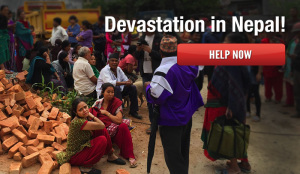Earthquake in Nepal: An Update

Bruce Smith
This weekend, the television news of the earthquake in Nepal was regularly interrupted by commercials for the upcoming release of the film San Andreas. Images of Dwayne Johnson leaning out the open door of a flying helicopter to rescue someone from a crumbling steel and glass skyscraper are a far cry from the real-life drama on the ground in Kathmandu. Picture instead ancient clay bricks falling from above, pummeling and burying people below, rifts in the ground making roads impassable, and building facades tilting precariously after their interior structures collapsed completely.
I picture the faces of people I know and love grimacing in pain—physically, emotionally, and spiritually. I see them cut off from communications with their families, sleeping outside in the cold rain, wondering where their next meal will come from. I hear them crying, sobbing in prayer. The good news is that God knows His children, hears their cries, and gives peace that surpasses understanding.
Others make their way to the shrines and temples, ringing bells and spinning prayer wheels, burning incense in a vain attempt to awaken gods of mankind’s own creation. The hopeless silence is deafening.
The international aid response is moving rapidly toward Nepal. I understand the airport is still open, which is fortunate since that will be the primary conduit for incoming aid. One interesting misconception about earthquakes is that all food suddenly disappears. A moment’s reflection reminds us that this is not true. But the normal food supply lines from the rural areas to the city are disrupted, so the food supply in Kathmandu will soon be insufficient. The governments of both China and India, which border Nepal, are responding with assistance.
One uncommonly known truth is that typically most of the assistance needed to respond to any disaster will come from within 100 miles of the location. While several provinces of Nepal have been affected, many others have not. The Himalayan mountains create a physical obstacle to assistance from the north, but the southern border with India provides several probable routes for assistance to reach Kathmandu by ground.
This is not the place for me to give detailed information about our people and partners on the ground in Nepal except to say that the information we have, so far, is that all are safe. Homes and offices are damaged. Ministry activities are disrupted. But the people in our immediate circle are safe. We expect that people in their Nepali family circles have been injured and killed. Disasters of this scope quickly reduce the normal degrees of separation.
Even as the international aid rapidly ramps up, experience shows that within a very short time, sometimes just days or weeks, international interest will move elsewhere and the aid to Nepal will stop. Often this leaves people in the rural areas completely beyond help. These least reached are the ones we are focusing on. We are already in communication with our local partners to evaluate the immediate needs, respond compassionately and appropriately, and strengthen our long-term partnership with these minority language groups.
You can share financially in our response in Nepal by going to the Wycliffe Associates website or by calling us toll-free at 1-800 THE WORD.
I’ll provide additional updates here in the coming days.


